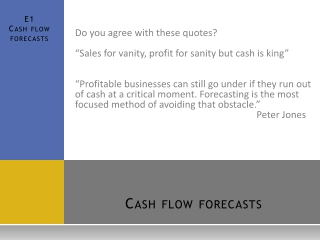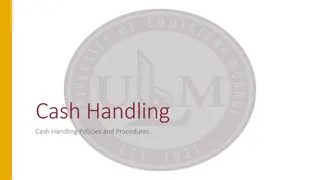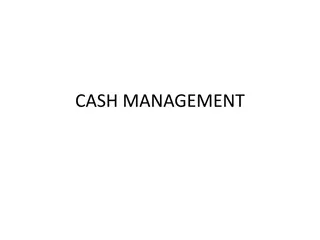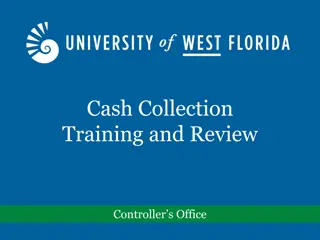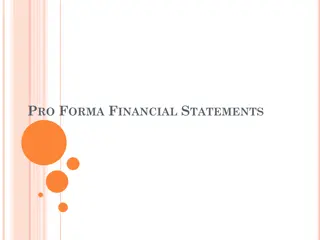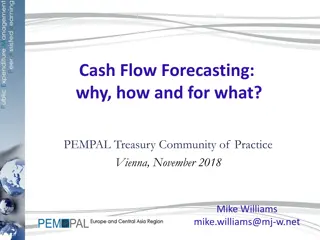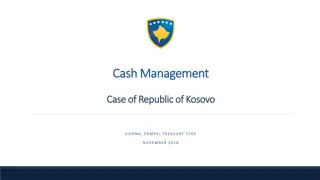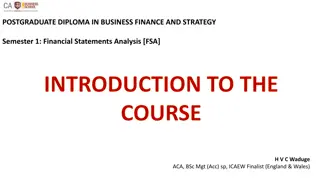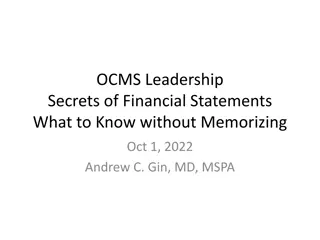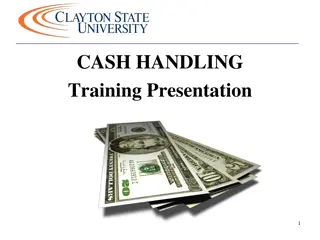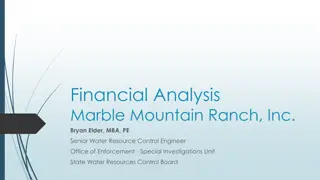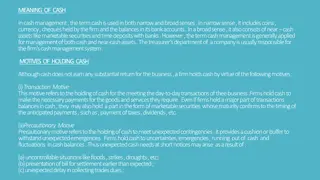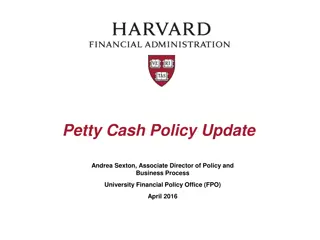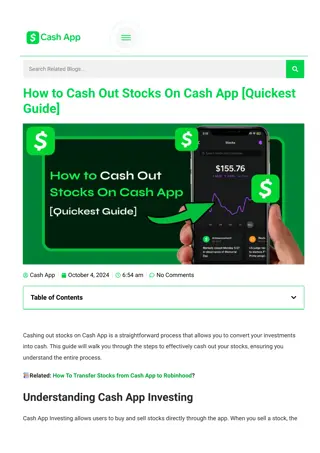Understanding Financial Statements and Cash Flow in Chapter 2
This chapter delves into the importance of financial statements in making crucial financial decisions by highlighting the disparities between accounting value and market value as well as accounting income and cash flow. It explains the balance sheet, assets, liabilities, owner's equity, and networking capital, providing insights into how these components play a vital role in assessing a firm's financial health.
Download Presentation

Please find below an Image/Link to download the presentation.
The content on the website is provided AS IS for your information and personal use only. It may not be sold, licensed, or shared on other websites without obtaining consent from the author. Download presentation by click this link. If you encounter any issues during the download, it is possible that the publisher has removed the file from their server.
E N D
Presentation Transcript
+ Financial statement, taxes, and cash flow CH 2
+Introduction Our emphasis is not on preparing financial statement. Financial statement are frequently a key source of information for financial decision. There are two important differences we have to understand: The difference between accounting value and market value. 1. The differences between accounting income cash flow. 2.
+2.1 the balance sheet The balance sheet is a financial statement showing a firm s accounting value on a particular date. On the left side we have what a firm owns (assets), and on the right side we have what the firm owes (liabilities).
+Assets Assets are classified as current or fixed assets. A fixed assets is has long life. Fixed assets can be tangible (truck, computer) or intangible (trademark, patent) . A current assets has a life of less than one year, that s mean the assets will convert to cash within 12 month.
+Liabilities and owners equity Liabilities are classified as current or long-term. Current liabilities have life less than one year (that s mean they must paid within the year). It listed before long-term liabilities in balance sheet. Example of current liabilities: Account payable (money the firm owes to suppliers). A debt that is not due in the coming year is classified as long- term liabilities. A firm will pay off it s debt in five year is a long- term debt. firm s borrow in long term from a variety sources. Bond and Bondholder refer to long-term debt and long-term creditors. The difference between total value of assets and total value of liabilities is the shareholder equity (common equity or owner s equity). If the firm were to sell its assets and use the money to pay off its debt. The value remaining would belong to shareholder.
+ Assets = Liabilities + Shareholders equity The right side will always equals to the left side in the balance sheet. Because shareholders equity is define as the differences between assets and liabilities.
+Networking capital Networking capital (NWC) is the difference between a firm s current assets and current liabilities. NWC is positive when current assets is exceed current liabilities, that s mean the cash that will become available over 12 month exceed the cash that must be paid. Assets Liabilities & equity Current liabilities Long-term liabilities Shareholders equity Total liabilities & shareholders equity Current assets Net fixed assets $100 $500 $70 $200 $330 $600 Total assets $600 NWC = 100 70 = $30
+liquidity Liquidity refers to the speed and ease with which an assets can be converted to cash. Gold is relatively liquidity assets but customer manufacturing facilities is not. A highly liquid assets is one that can be quickly sold without significant loss of value. An illiquid assets is one that cannot be quickly converted to cash without a substantial price reduction. The most liquid assets listed first in the balance sheet. Fixed assets are relatively illiquid, these consist tangible things like building and equipment, that don t convert to cash in normal business activity. Intangible have no physical existence. Liquidity is voluble, the more liquid a business is, the less likely to have financial distress. Liquid assets are less profitable to hold.
+Debt versus equity The use of debt in a firm s capital structure is called financial leverage. The more debt a firm use, the greater is its degree of leverage. Financial leverage increase the potential reward to shareholder, but increase the potential for financial distress and business failure. The firm s capital structure have equity and debt, the total percentage of them is equal to 100%.
+Market value versus book value The value shown in the balance sheet for the firm s assets are book values. Generally the book value are not what the assets are actually worth. Generally Accepted Accounting Principals (GAAP) show assets at historical cost, no mater how long ago they were purchased or how much they are worth today. For current assets, market and book value could be the same, because assets are bought and converted into cash in a short time. Fixed assets would be purely a coincidence if the actual market value of an assets were equal to its book value. The differences between book and market (economic) value is important for understanding the impact of reported gains and losses. The market value of an assets depend on things like its riskiness and cash flow, neither of which have anything to do with accounting.
+ In this example, Shareholders equity worth almost twice as mush as book value. Klingon Corporation Balance sheet Market value versus book value Assets Book Market Net working capital Net fixed assets $700 Liabilities & Shareholder s Equity Book $500 Market $500 $400 $600 Long-term debt $1,000 Shareholders equity $600 $1,100 $1,100 $1,600 $1,100 $1,600
+2.2 income statement Income statement measures performance over some period of time, usually a quarter or a year. The income statement equation is: Revenues Expenses=Income U.S corporation, 2009 income statement ($ in millions) Net sale - Cost of goods sold - Depreciation = EBIT - Interest paid - Taxable income Taxes (34%) = Net income - Dividends = Additional to retained earnings $1,509 $750 $65 $694 $70 $624 $212 $412 $103 $309
+Suppose U.S had 200 million share out standing at the end of 2009. based on the income statement, what was EPS? What were dividends per share? Earning per share=Net income/total share outstanding. =$412/200=$2.06 per share. Dividends per share=total dividends/total share outstanding. = $103/200=$0.515 per share.
+GAAP and income statement The general rule is to recognize revenue when the earning process is virtually complete and the value of an exchange of goods or services is known or can be reliably determined
+Noncash items A primary reason that accounting income differs from cash flow is that an income statement contains noncash items. Noncash items: is expenses charged against revenues that do not directly affected cash flow such as depreciation. Depreciation can be straight-line, the assets written down to zero over the period (the depreciation deduction in the same amount every year) for example $5,000/5year=$1,000 each year for 5 year. This $1,000 is not cash, it is accounting number. The actual cash flow occurred when the assets was purchased. The timing of cash inflow and outflow is very important to estimate the market value of a company.
+2.3 Taxes Taxes can be the largest cash outflow a firm experiences. The size of the company s tax bill is determines by the tax code. The tax code is the result of political not economy.
+Corporate tax rate The percentage tax rate shown in the table are all marginal rate. Put the tax rate in the table apply to part of income in indicated range only, not all income. Taxable income 0-50,000 50.001-75,000 75,001-100,000 100,001-335,000 335,001-10,000,000 10,000,001-15,000,000 15,000,001-18,333,333 18,333,334+ Tax rate 15% 25% 34% 39% 34% 35% 38% 35%
+Average versus marginal tax rate In making financial decision it is important to distinguish between average and marginal tax rate. Average tax rate: is your tax bill divided by your taxable income, that s mean the percentage of your income that goes to pay tax. Marginal tax rate: is the rate of extra tax you would pay if you earned one more dollar
+Example To understand the differences between average and marginal tax rate Suppose our corporation has a taxable income of$200,000. what is the tax bill? By using the table : 0.15*($50,000)= $7,500 0.25*($75,000-$50,000)=$6,250 0.34*($100,000-$75,000)=$8,500 0.39*($200,000-100,000)=$39,000 $7,500+$6,250+$8,500+$39,000=$61,250 is the total tax We have taxable income of $200,000 and the taxable bill of $61,250. So the average tax rate is $61,250/200,000=30.625% The marginal tax rat: if we made one more dollar, the tax on that dollar would be 39 cents, so the marginal rate is 39%.
+ (1) (2) (3) (3)/(1) Average tax rate 15.00% 17.86% 21.63% 32.30% 34.00% 34.86% 35.00% 35.00% Taxable income $45,000 $70,000 $95,000 $250,000 $1,000,000 $17,000,000 $50,000,000 $100,000,000 Marginal tax income 15% 25% 34% 39% 34% 38% 35% 35% Total tax $6,750 $12,500 $20,550 $80,750 $340,000 $6,100,000 $17,500,000 $35,000,000
+ With Flat tax rate there is only tax rate, so the rate is the same for all income level. with Flat tax rate the marginal tax rate is always the same as the average tax rate. Normally the marginal tax rate is relevant for financial decision making. The reason is that any new cash flow will be taxed at the marginal rate. Because financial decision usually involve new cash flow or change in excising one, this rate will tell us the marginal effect of decision on our tax bill.
+2.4 cash flow Cash flow: is the differences between the number of dollar that came in a and the number that went out. No standard financial statement present this information about cash flow as we wish. There is a standard financial accounting statement called statement of cash flow. From balance sheet we know that the value of a firm s assets is equal to the value of its liabilities plus the value of its equity. Cash flow from assets=cash flow to creditors +cash flow to stockholder
+Cash flow from assets Cash flow from assets: the total of cash flow to creditors and cash flow to stockholder, consisting of the following: operating cash flow, capital spending, and change in net working capital. Operating cash flow: is the cash flow that result from the firm s day-to-day activities of producing and selling. Expenses associated with firm s financing of its assets are not included because they are not operating expenses. Some of the firm s cash flow is reinvested in the firm, capital spending refer to the net spending on fixed assets(purchases of fixed assets less sale of fixed assets). Change in net working capital is measured as net change in current assets relative to current liabilities for the period being examined and represent the amount spend on net working capital.
+Operating cash flow To calculate OCF we need to calculate revenue minus cost. But we don t want to include depreciation because it s not cash outflow, and we don t want to include interest because it s a financing expense. We do want to include taxes because are paid in cash. Example U.S. corporation s income statement. We need to make two adjustment. First: recall that depreciation is a noncash expense. To get cash flow we first add back the $65 in depreciation because it wasn t a cash deduction. Second: is to subtract the $212 in taxes because these were paid in cash. U.S corporation 2009 operating cash flow Earnings before interest and taxes + depreciation - taxes = operating cash flow $694 $65 $212 $547
+ OCF is an important number because it till us whether a firm s cash inflow from its business operations are sufficient to cover its every day cash outflow. The accounting practice, OCF defined as net income plus depreciation. The accounting definition differs from our in one important way: interest is deducted when net income is computed.
+Capital spending Net capital spending is just money spent on fixed assets less money received from the sale of fixed assets. Net capital spending during the year in U.S. corporation: Ending net fixed assets $1,709 - Beginning net fixed assets + Depreciation = Net capital spending $1,644 %65 $130 Could net capital spending be negative? Yes, it would happen if the firm sold off more assets than it purchase.
+Change in net working capital In addition to invest in fixed assets, a firm will also invest in current assets. As the firm change its investment in current assets, its current liabilities will usually change as well. To determine the change in net working capital, the easiest approach is just to take the difference between the beginning and ending net working capital. Ending NWC - Beginning NWC = Chang in NWC $1,014 $684 $330
+ To calculate cash flow from assets: U.S. corporation 2009 cash flow from assets Operating cash flow - Net capital spending - Chang in NWC = Cash flow from assets $547 $130 $330 $87 $78 is the sum of firm s cash flow to creditors and its cash flow to stockholder. Cash flow from assets sometime goes by a different name ( free cash flow).
+Cash flow to creditors and stockholders The cash flow to creditors and stockholders represent the net payment to creditors and owners during the year. Cash flow to creditors in interest paid less net new borrowing. And some time it called cash flow to bondholder U.S corporation 2009 cash flow to creditors Interest - Net new borrowing = Cash flow to creditors $70 $46 $24 Cash flow to stockholders is dividends paid less net new equity raised. U.S corporation 2009 cash flow to stockholder Dividends paid _ Net new equity raised = Cash flow to stockholder $103 $40 $63
+ The cash flow from assets is equal to $87, and the cash flow to creditors and stockholder is equal to $24+$63=$87. in this way we make sure that we did not make any mistake. Summary: 1- the cash flow identity Cash flow from assets=cash flow to creditors + cash flow to stockholder 2- cash flow from assets Cash flow from assets= OCF-net capital spending- Chang in NWC Where OCF= EBIT + Depreciation Taxes Net capital spending=ending net fixed assets-beginning net fixed assets + depreciation Change in NWC=ending NWC-beginning NWC 3- Cash flow to creditors (bondholders) Cash flow to creditors=interest paid- net new borrowing 4- cash flow to stockholders Cash flow to stockholders =dividends paid- net new equity raised
+ Example: cash flow for Dole Cola: ch2 in the text book page35 (solved in the text book).
+Assignment Problems 11, 12, 13, 14 Text book, ch2, page 42
+Review .Which one of the following is the financial statement that shows the accounting value of a firm's equity as of a particular date? A.income statement B.creditor's statement C. balance sheet D.statement of cash flows E.dividend statement The common set of standards and procedures by which audited financial statements are prepared is known as the: A.matching principle. B.cash flow identity. C. Generally Accepted Accounting Principles. D.Financial Accounting Reporting Principles. E.Standard Accounting Value Guidelines.
+Review Noncash items refer to: A.accrued expenses. B.inventory items purchased using credit. C.the ownership of intangible assets such as patents. D. expenses which do not directly affect cash flows. E.sales which are made using store credit. The percentage of the next dollar you earn that must be paid in taxes is referred to as the _____ tax rate. A.mean B.residual C.total D.average E. marginal


